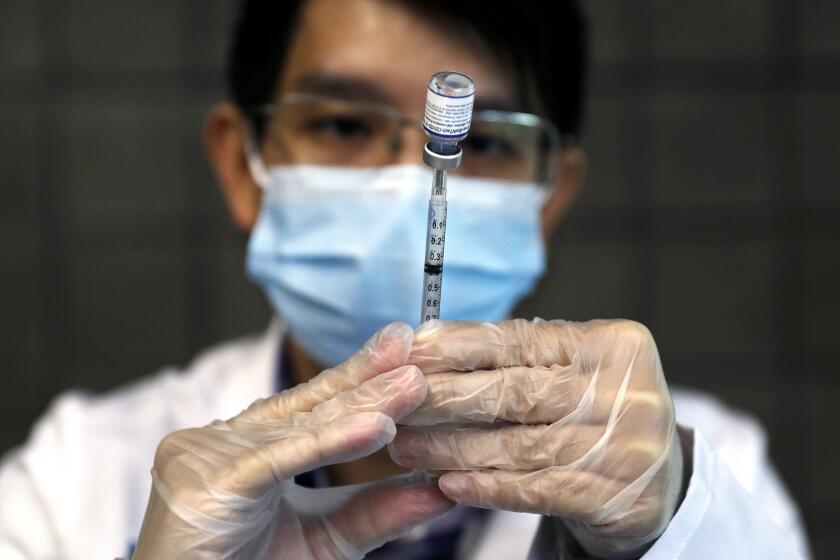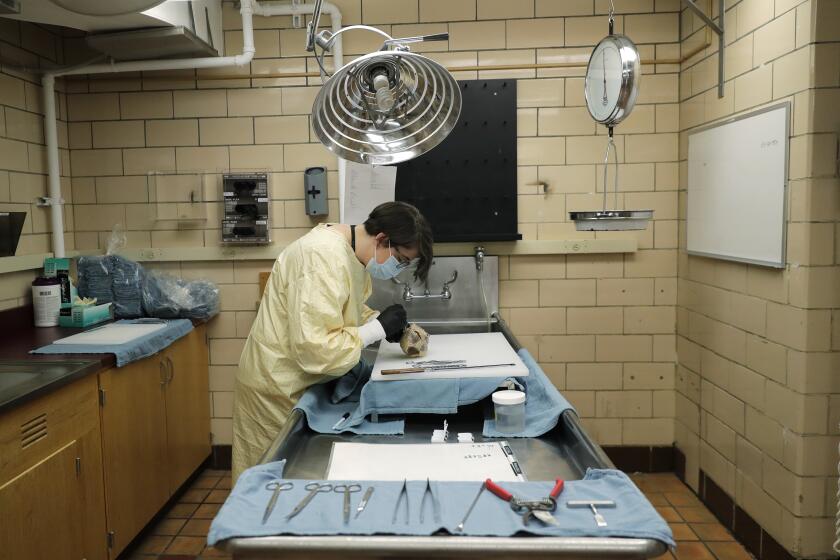Terror of long COVID remains common even as pandemic eases, data show

- Share via
Long COVID remains common after coronavirus infection, even as cases of the syndrome have decreased since the start of the pandemic, according to the U.S. Centers for Disease Control and Prevention.
However, data increasingly suggest that getting vaccinated reduces the risk of long COVID among children and adults — a factor health officials have cited as part of the rationale behind recommending virtually all Americans get a newly formulated vaccine this year.
“Those who do not get a COVID-19 vaccine have an increased likelihood of developing long COVID,” CDC epidemiologist Sharon Saydah said during a recent meeting of the agency’s Advisory Committee on Immunization Practices.
A new COVID-19 vaccine is coming, and health officials are recommending most everyone get it. But how many people are willing to roll up their sleeves again?
Long COVID refers to a wide range of physical and mental health problems that persist four or more weeks after a coronavirus infection. While research has hinted at a possible correlation between the severity of initial infection and likelihood of developing long COVID, the syndrome can afflict even those who had only mild symptoms — or none at all.
According to data from the 2022 federal National Health Interview Survey, 9% of U.S. adults age 35 to 49 reported having long COVID-19 at some point, with 4.7% saying they currently had long COVID at the time they were surveyed, Saydah said. That age range was the most affected by long COVID.
Among those age 50 to 64, 7.4% reported ever having long COVID, while 3.8% said they currently had the syndrome. For those age 65 and older, 4.2% said they had long COVID at some point, while 2.3% said they currently had it.
Among the youngest adults, up to age 34, 6.8% described ever having long COVID, while 2.7% said they currently had it.
“Post-COVID conditions are common following SARS-CoV-2 infection,” said Megan Wallace, another CDC epidemiologist.
One in 10 people infected with the coronavirus during the Omicron era suffered from long COVID, indicating the syndrome remains a notable threat.
The prevalence of long COVID decreased from June 2022 to January 2023 but remained steady through the first half of this year, according to survey data.
“However, approximately one in four adults who currently report having long COVID report that it includes significant activity limitations. And this proportion has not changed in the past year,” Saydah said.
Those findings were detailed in a study published by the CDC in August and, researchers wrote, “highlight the importance of COVID prevention, including staying up to date with recommended COVID-19 vaccination, and could inform health care service needs planning, disability policy, and other support services for persons experiencing severe activity limitation from long COVID.”
One of the more curious aspects of long COVID is the sheer range of symptoms linked to the syndrome. Among them are postexertional malaise (in which a person feels worse after even minor physical or mental exertion); moderate or severe fatigue; dizziness; brain fog; gastrointestinal symptoms; heart palpitations; changes in desire for or capacity for sex; loss of smell or taste; excessive thirst; chronic cough; chest pain; and abnormal movements.
Most L.A. County residents who had long COVID reported symptoms severe enough to limit daily activities weeks after they were infected, a survey found.
The root cause of long COVID has not been definitively established, though researchers are examining several possible explanations.
“We have not figured out who gets long COVID and who doesn’t. And we have not figured out necessarily who, for sure, isn’t going to experience some severe illness,” said Los Angeles County Public Health Director Barbara Ferrer.
That’s why it’s so important that people continue to get updated COVID-19 vaccinations, doctors say.
“We now have even more data showing that vaccines can also lessen the risk of getting post-COVID conditions, including long COVID,” said Dr. Nava Yeganeh, medical director of L.A. County’s Vaccine Preventable Disease Control Program.
Three years and $62,000 in medical expenses later, a musician and her caregiving partner struggle to navigate the financial, mental and physical challenges of long COVID.
Researchers have uncovered specific long-term conditions that are associated with coronavirus infections among children and adults, Saydah added.
Among children and adolescents, coronavirus infection was associated with an increased risk of heart conditions, kidney failure, blood clots, diabetes, fatigue, smell and taste disorders and neurological conditions.
Among adults who had COVID-19, 1 in 5 reported a health condition that might’ve been related to their COVID-19 illness, including neurological or mental health conditions; kidney failure; blood clots; and musculoskeletal, cardiovascular or respiratory conditions.
“The symptoms and conditions of long COVID can persist for months or years after acute infection, and they also emerge or reemerge over time,” Saydah said.
Scientists are exploring whether some of the most infectious coronavirus variants came from chronically infected individuals with weakened immune systems.
In a prospective study of adults who had acute COVID-19-like illness — whether or not they tested positive for a coronavirus infection — “we found that ongoing symptoms decreased after three months, but approximately 16% continued to experience ongoing symptoms at 12 months,” Saydah said.
Among military veterans, researchers found that long COVID conditions decreased 90 days after the acute coronavirus infection, but that there was an increased risk of new conditions continuing for up to two years after the acute COVID-19 illness, Saydah added.
More to Read
Sign up for Essential California
The most important California stories and recommendations in your inbox every morning.
You may occasionally receive promotional content from the Los Angeles Times.



















